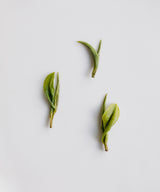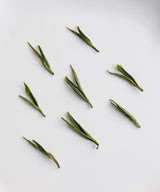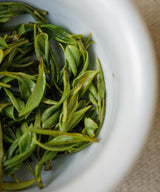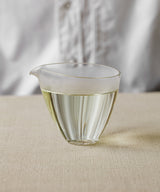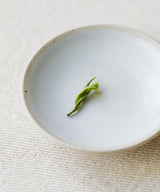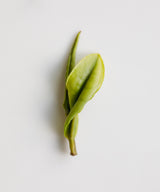Anji Baicha High Mountain 2025
高山安吉白茶
Harvest
April 5, 2025
Origin
Anji, Zhejiang
With gratitude for Ms. Qun, we have an even higher grade of her private room Anji Baicha to offer this year, harvested earlier in the picking season than ones we previously received. It is especially intriguing at first glance, as we see that the needle shaped tea leaves are slightly shorter and darker, making them look even more vibrant, as though they just sprouted from a conifer tree. In a warm gaiwan these spindles illuminate, emitting an intense and beautiful aroma: mineralic, tropical, like mango skin and wet metal.
Under water they become plump, lively, and the most Spring shade of green, like peas, bean pods, and asparagus. As suggested by this colour, they brew a very fresh and nutritive tasting liquor; savoury at first, with a sweet, lemony finish. A gently coarse mouthfeel slows the liquor’s passage across the palate, giving us a bit more time to open receptively to everything it has to offer – which is much!
. . .
For lack of a better name, we call this Private Room tea from Ms. Qun “High Mountain Anji Baicha.” While Ms. Qun’s legendary Anji Baicha trees are only slightly higher in elevation than others, this is such an exceptional and otherworldly expression of Anji Baicha, we must somehow indicate its difference.
For many people, and across cultures, Anji Biacha is a highly anticipated, and highly appreciated, Spring tea. The name “Anji Baicha” is obscuring: while in this case it refers to a green tea, “baicha” translates to “white tea.” The varietal has been named this way because of its unusually colourless leaves: due to their lower chlorophyll and higher amino acid content, Anji Baicha leaves are a near-translucent, pale green. When dried, these pale, uniform leaves lay very flat like pine needles. Distinct to them is a dark, green vein which runs down the spine of each leaf, with fine arteries branching off of it. In water these flat, papery leaves behave in an unusual way: they unfold by spiraling open, from something flat to something multidimensional, gradually revealing their striking emerald markings. When these leaves are fully open and suspended in the gaiwan, they look like auspicious cranes.
Anji Baicha was the favourite tea of a legendary ruler of the Song Dynasty, Emperor Huizong. He was a gifted poet, painter, calligrapher, and very engaged with the tradition of tea. In 1107 Huizong authored a treatise on tea called Daguan Chalun. In it, he describes Baicha tea at length; he believed it to be very special amongst teas for its pale, delicate appearance, and noted that it grew sporadically on cliffs, and therefore resisted being domesticated by man. This Baicha, that Emperor Huizong so admired, remained a mysterious reference in his text for several centuries, until, in 1982, Baicha trees were discovered in the high mountains of Anji County.
With the notoriety that this varietal now has, a handful of highly regarded cultivars have come to exemplify Anji Baicha production, Ms. Qun being one of them. Her Anji Baichas are so sought after, they do not normally appear on the market, which is why we call them Private Room teas. These are extremely small batched teas intended for special occasions, or, had they appeared at a different time, teas that would be reserved only for an Emperor. It is through the trust of my tea mentor in Beijing that Cultivate was able to acquire the contact for Ms. Qun, and it is only on account of friendship that we are fortunate enough to carry a small portion of her tea.
. . .
Brewing guide
| Tea | 3 g |
| Temperature | 80°C |
| Water | 120 ml |
| Steep time | 10 - 60 sec |
| No. of infusions | 8-10 |

